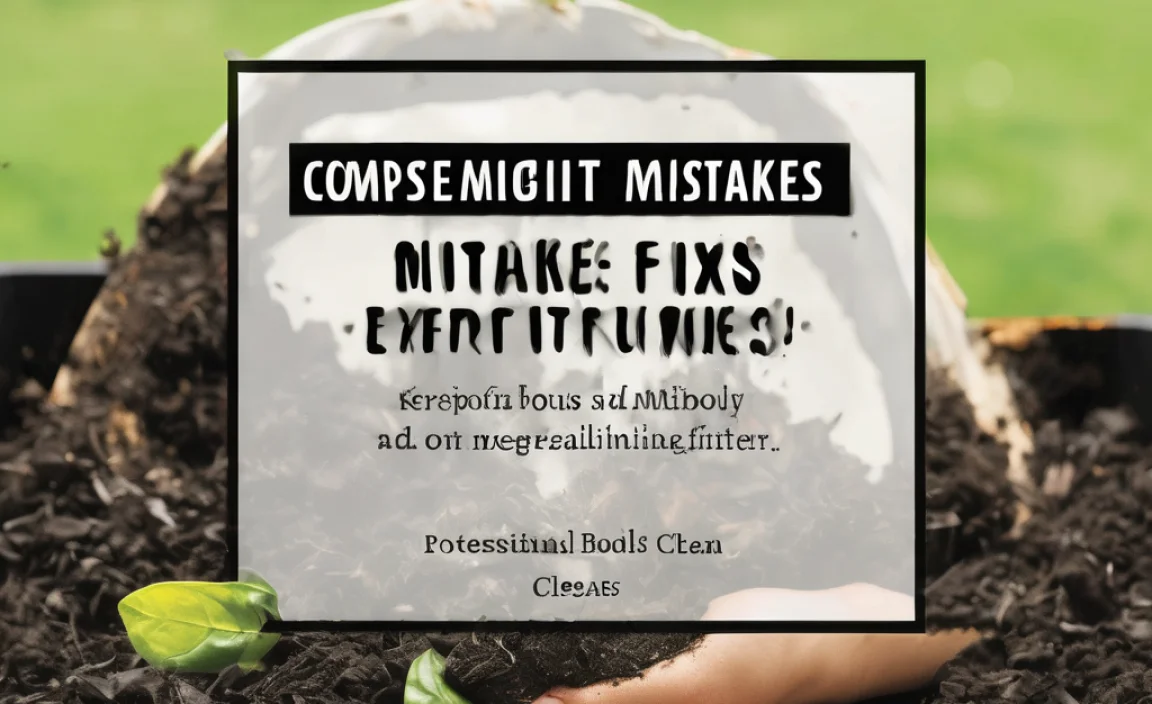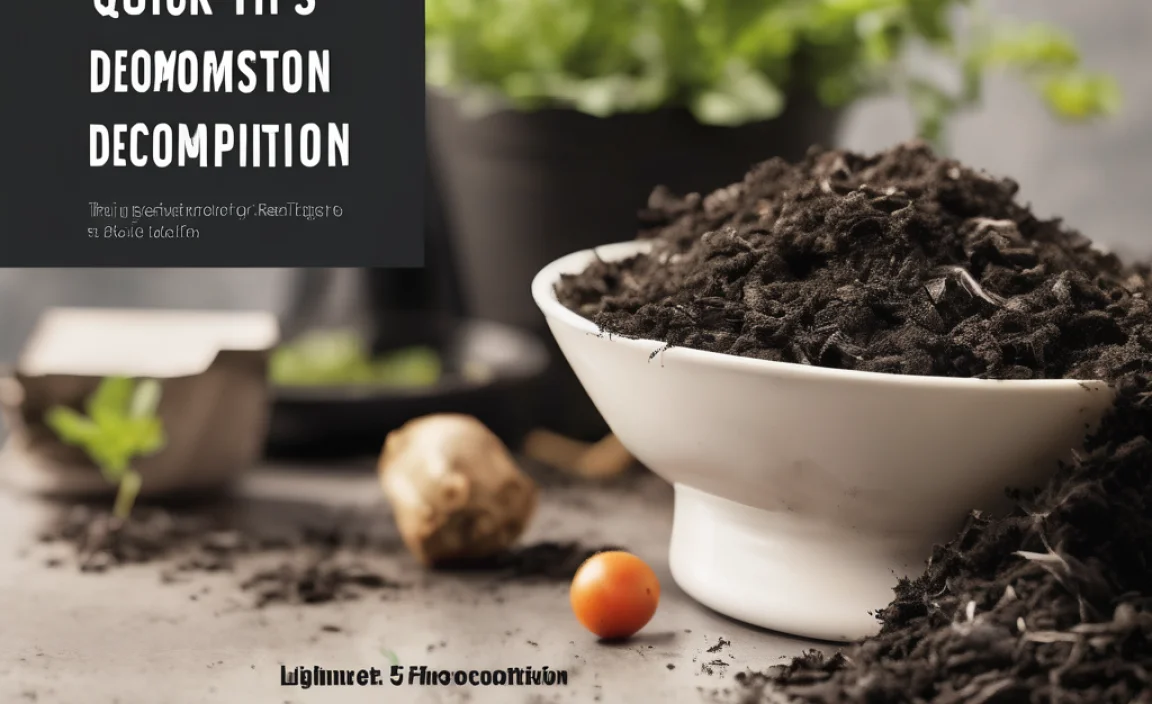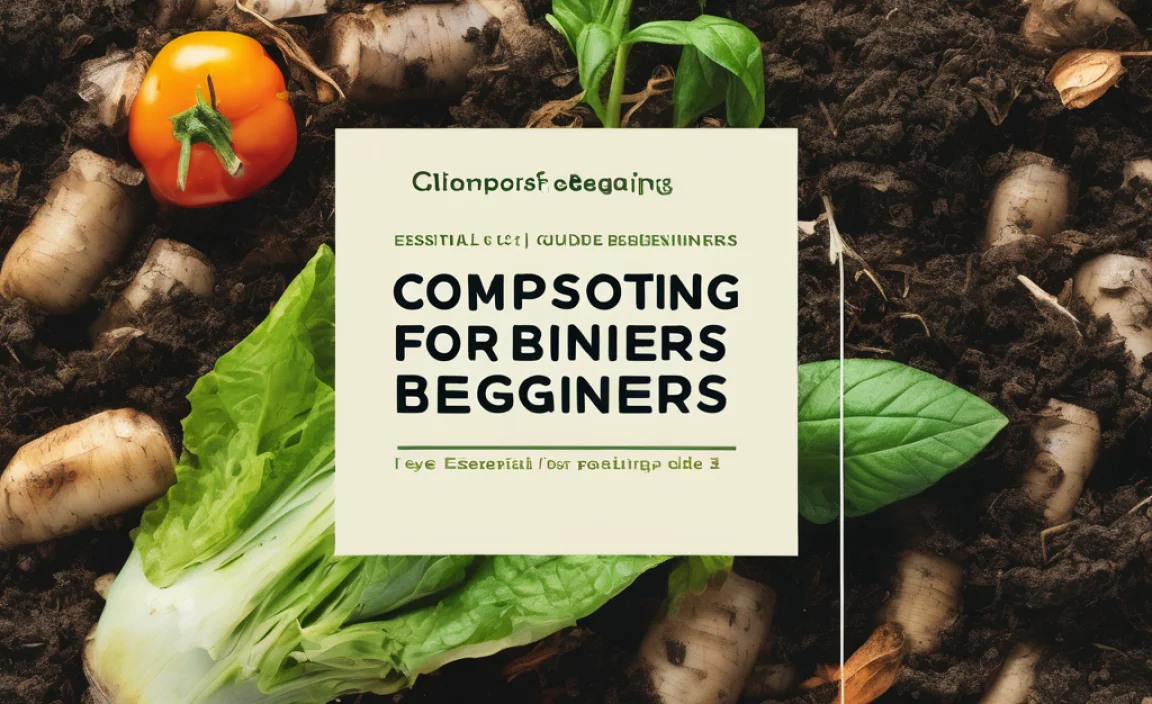“`html
Compost vs Potting Mix Guide: Essential Insights!
Ever stood in the garden center aisle, totally baffled by the bags of “compost” and “potting mix”? You’re not alone! Figuring out which one to use for your plants can feel like a garden mystery. But it doesn’t have to be! I’m Troy D Harn from TopChooser, and I’m here to break it all down for you. We’ll go from confused to confident, making sure your plants get exactly what they need to thrive. Let’s dig in and clear things up!
What’s the Big Deal Between Compost and Potting Mix?
It’s one of those questions that pops up when you’re getting your hands dirty at home. Whether you’re a seasoned gardener or just starting to grow a few herbs on your windowsill, you’ve probably wondered: “Can I just use compost for everything?” or “What exactly is potting mix?” This guide is your friendly neighbor’s quick rundown to help you pick the perfect pals for your plants.
Think of it this way: they both help plants grow, but they do it in different ways and are best suited for different jobs. We’ll explore what makes them tick, where they shine, and how to use them like a pro. By the end, you’ll have a clear picture and feel ready to grab the right bag for your next planting project.
Understanding Compost: Nature’s Own Soil Builder
Compost is essentially recycled organic matter. It’s the product of decomposed kitchen scraps, yard waste, and other natural materials. When done right, it’s a dark, crumbly, nutrient-rich material that smells earthy and full of life. It’s less about being a “soil” on its own and more about being an amendment – something you add to existing soil to improve it.
Where Does Compost Come From?
- Kitchen Scraps: Fruit and vegetable peels, coffee grounds, tea bags, eggshells.
- Yard Waste: Grass clippings, leaves, small twigs, shredded paper.
- Manure: Well-rotted animal manure (from herbivores like cows, horses, chickens).
- Other Materials: Sawdust, shredded cardboard, plant trimmings.
The magic of composting happens thanks to tiny organisms like bacteria, fungi, and worms. They break down these materials over time. For home gardeners, this means you can create your own nutrient powerhouse from what you’d otherwise throw away!
The Superpowers of Compost
Compost is a real champion for your garden soil. Its benefits are numerous and all-around fantastic for plant health and soil structure.
- Enriched Nutrients: It’s packed with essential nutrients that plants need to grow strong and healthy. Think of it as a multivitamin for your soil.
- Improved Soil Structure: Compost helps sandy soils retain moisture and nutrients, while it loosens up heavy clay soils, allowing for better drainage and aeration. This means happier roots!
- Enhanced Microbial Activity: It introduces beneficial microbes to the soil, creating a vibrant ecosystem that helps plants resist diseases and pests.
- Better Water Retention: Compost acts like a sponge, holding onto moisture in the soil. This means you might need to water less often, saving you time and water.
- pH Balancing: Compost can help buffer the soil’s pH, bringing it closer to a neutral range that most plants prefer.
When to Use Compost
Compost is incredibly versatile. You can use it in so many ways around your home garden.
- Amending Garden Beds: Mix it generously into your vegetable garden or flower beds before planting. This is probably its most common and beneficial use. Aim for about a 2-4 inch layer worked into the top 6-8 inches of soil.
- Top Dressing Lawns: Spread a thin layer of compost over your lawn in spring or fall to improve soil health, encourage thicker grass growth, and reduce thatch.
- Mulching: A layer of compost around trees and shrubs helps retain moisture, suppress weeds, and slowly feed the soil.
- Potting Mix Ingredient: While not usually recommended as the sole component for container plants, compost can be a valuable part of a homemade potting mix.
A Word of Caution for Compost
While compost is amazing, it’s important to know that not all compost is created equal. If you buy compost, look for reputable sources. Some homemade compost might not be fully decomposed, which can sometimes temporarily tie up nitrogen as it finishes breaking down. Also, compost can sometimes contain weed seeds if the composting process wasn’t hot enough to kill them. Always use well-finished, mature compost for best results.
Understanding Potting Mix: The Engineered Solution for Containers
Potting mix, also often called potting soil (though it rarely contains actual soil!), is a specially formulated blend of ingredients designed to provide the ideal environment for plants grown in containers. Unlike garden soil or even compost, potting mix is engineered for lightness, drainage, aeration, and consistent moisture retention – all crucial for plants living in pots, hanging baskets, or raised beds where soil can easily compact and dry out.
What’s Inside a Typical Potting Mix?
Potting mixes are usually a carefully balanced combination of several ingredients, often excluding actual garden soil to prevent compaction and disease. Common components include:
- Peat Moss or Coco Coir: These provide a lightweight, moisture-retentive base. Peat moss comes from decomposed sphagnum moss, while coco coir is made from coconut husks. Coco coir is a more sustainable alternative to peat moss.
- Perlite or Vermiculite: These are volcanic rocks that have been heated to expand. Perlite looks like tiny white Styrofoam balls and is excellent for aeration and drainage. Vermiculite is flakier and helps retain moisture and nutrients.
- Composted Bark or Wood Fines: These add structure and improve drainage.
- Lime: Often added to balance the acidity of peat moss.
- Starter Fertilizers: Many include a small amount of slow-release fertilizer to give plants a boost right after planting.
The Benefits of Potting Mix
Potting mix is specifically designed to overcome the challenges of growing plants in enclosed spaces like pots.
- Excellent Drainage: Container plants can easily drown if their roots sit in waterlogged soil. Potting mixes are designed to let excess water drain away quickly.
- Good Aeration: Roots need oxygen! The airy structure of potting mix ensures there’s enough air circulation around the roots.
- Lightweight: This is important for pots, especially larger ones, making them easier to move.
- Sterile (Often): High-quality potting mixes are often sterilized to eliminate weed seeds, diseases, and pests that could harm your container plants.
- Consistent Moisture: While allowing drainage, they also hold enough moisture to keep the soil evenly damp between waterings.
When to Use Potting Mix
The name says it all! Potting mix is your go-to for plants that aren’t in the ground.
- All Container Plants: This includes potted flowers, herbs, vegetables in containers, and houseplants.
- Seed Starting: Some “seed starting mixes” are a type of potting mix, very fine and optimized for germination. But many general potting mixes work well too.
- Hanging Baskets: Their lightness is a big advantage here.
- Raised Beds (Sometimes): For very lightweight and well-draining raised beds, a potting mix can be used, though it’s often more cost-effective to use a blend of compost and topsoil.
A Word of Caution for Potting Mix
Potting mix often has limited nutrients once the initial starter fertilizer is used up. You’ll need to supplement with liquid fertilizers or slow-release granules as your plants grow. Also, it can dry out very quickly, especially in hot weather or windy conditions, so keep an eye on watering needs. Avoid using it straight from the bag to amend large garden beds, as it can sometimes be too light and may not hold moisture or nutrients as effectively as heavier compost or garden soil.
Compost vs Potting Mix: Key Differences at a Glance
To make it super clear, let’s put the main differences side-by-side. This table should help you quickly identify which one is right for your project.
| Feature | Compost | Potting Mix |
|---|---|---|
| Primary Use | Amending garden soil, improving structure, adding nutrients. | Growing plants in containers (pots, hanging baskets, raised beds). |
| Texture | Crumbly, dense, earthy. Varies based on ingredients. | Light, fluffy, airy. Engineered for drainage and aeration. |
| Nutrient Content | Rich in diverse micronutrients and macronutrients. | Often low in nutrients; may contain starter fertilizer. Requires regular feeding. |
| Drainage | Improves drainage in clay soil; retains moisture in sandy soil. | Designed for excellent drainage to prevent waterlogging in containers. |
| Aeration | Improves soil aeration. | Excellent aeration for root health in confined spaces. |
| Origin | Decomposed organic matter (household waste, yard waste, manure). | Manufactured blend of peat, coco coir, perlite, vermiculite, bark, etc. |
| Best For | Vegetable gardens, flower beds, lawns, mulching. | Houseplants, annuals/perennials in pots, seed starting, hanging baskets. |
Can You Use Them Together? Absolutely!
The best part? You don’t always have to choose just one! In many cases, combining compost and potting mix can give you the best of both worlds, especially for certain container gardening scenarios or if you’re building new raised beds.
Creating Your Own Potting Blend
For a supercharged container mix, you can blend store-bought potting mix with your own compost. A common recommendation is a 50/50 mix, or even 2 parts potting mix to 1 part compost. This adds more nutrients and improves the moisture-holding capacity of the potting mix, while the potting mix still provides the essential drainage and aeration.
Why this works:
- Nutrient Boost: Compost feeds your plants naturally.
- Better Structure: Compost can help the lighter potting mix hold together better.
- Cost Savings: Using some homemade compost can reduce the amount of purchased potting mix you need.
For raised beds, you might use a mix of compost, topsoil, and maybe a bit of potting mix or perlite for extra drainage, depending on what you’re planting. The aim is always healthy soil that supports strong roots!
For more on building healthy soil, check out resources like the USDA Natural Resources Conservation Service’s Soil Health page. They have tons of great info on soil science and best practices.
DIY Compost: A Greener Choice
Making your own compost is a rewarding way to reduce waste and create a fantastic soil amendment for free. It may seem intimidating, but it’s quite straightforward. Here’s a simplified look at how you can start composting at home.
Simple Steps to Home Composting
- Choose Your Bin: You can buy a compost bin, build one from wood pallets, or simply use a designated pile in a corner of your yard. A bin helps keep things tidy.
- Gather Your Materials: You need a mix of “greens” (nitrogen-rich, like kitchen scraps and grass clippings) and “browns” (carbon-rich, like dry leaves, shredded paper, and twigs). A good ratio often cited is roughly 2-3 parts browns to 1 part greens by volume.
- Layering: Start with a layer of browns at the bottom for aeration. Then, add alternating layers of greens and browns. Bury kitchen scraps in the middle of the pile to deter pests.
- Moisture: Keep the compost pile about as damp as a wrung-out sponge. Too dry, and it won’t break down; too wet, and it can get smelly and anaerobic. Add water if it’s dry, or turn it and add more browns if it’s too wet.
- Aeration: Turn the compost pile regularly with a pitchfork or compost aerator. This introduces oxygen, which is crucial for the decomposition process and speeds it up. Aim to turn it every 1-4 weeks.
- Patience: Depending on your method, temperature, and how often you turn it, compost can be ready in anywhere from a few months to a year. You’ll know it’s ready when it’s dark, crumbly, and smells earthy.
For more detailed guidance on home composting, the Environmental Protection Agency (EPA) offers excellent resources specifically for home composting.
DIY Potting Mix: Saving Money and Controlling Ingredients
If you want to get really hands-on, you can make your own potting mix. This is a great way to save money, especially if you have a lot of containers, and to control exactly what goes into your plants’ homes. It’s a bit more involved than just buying a bag, but totally doable!
A Basic DIY Potting Mix Recipe
Here’s a simple recipe to get you started:
- 2 parts Peat Moss or Coco Coir (for moisture retention)
- 1 part Perlite or Vermiculite (for drainage and aeration)
- 1 part Compost (for nutrients and soil structure)
Steps to mix:
- In a large tub or on a tarp, thoroughly combine your chosen base material (peat moss or coco coir).
- Add the perlite or vermiculite and mix well.
- Incorporate your compost. Ensure everything is evenly distributed.
- If you’re using peat moss, which can be acidic, you might want to add a small amount of lime (follow package directions) to buffer the pH, especially if your plants are sensitive.
- Moisten the mix lightly if it feels too dry.
This mix provides a good balance of moisture retention, drainage, aeration, and nutrients. It’s a solid all-purpose potting mix for most container plants.
Choosing the Right Product: Practical Tips
Navigating the garden center can be a breeze once you know what you’re looking for. Here are some practical tips to help you make the best choice for your plants.
For Your Garden Beds (In-Ground):
Your goal here is to enhance the existing soil. You’re likely looking for:
- Compost: Buy bagged compost (check the ingredients to ensure it’s just compost!) or look for bulk compost from a local garden center or municipality. Bagged compost is easier for small jobs, while bulk is great for larger areas.
- Soil Amendments: Sometimes you’ll see products labeled “garden soil” or “soil conditioner.” These can be a mix of topsoil, compost, and other materials, and can be useful for filling or amending beds.
- Avoid: Pure potting mix for large in-ground beds, as it can be too light and costly.
For Pots, Containers, and Hanging Baskets:
Here, lightness, drainage, and aeration are key. You’ll want:
- Potting Mix: Buy bags labeled “potting mix” or “container mix.” Read the ingredients to ensure it contains perlite or vermiculite for drainage. Brands like Miracle-Gro, Pro-Mix, and Espoma offer various options.
- Potting Mix Additives: If you’re making your own, you’ll buy peat moss/coco coir, perlite, and vermiculite separately.
- Avoid: Garden soil or compost straight from the yard. They compact too easily in pots, leading to poor drainage and root rot.
For Seed Starting:
Seeds need a very fine, light, and sterile medium to germinate. Look for:
- Seed Starting Mix: These are specifically formulated for tiny seeds. They are fine-textured and usually have fewer nutrients, as seedlings get their initial energy from the seed itself. Many are peat-free or coco coir-based.
- Potting Mix (with caution): Some finer potting mixes can

I am passionate about home engineering. I specialize in designing, installing, and maintaining heating, ventilation, and air conditioning systems. My goal is to help people stay comfortable in their homes all year long.



